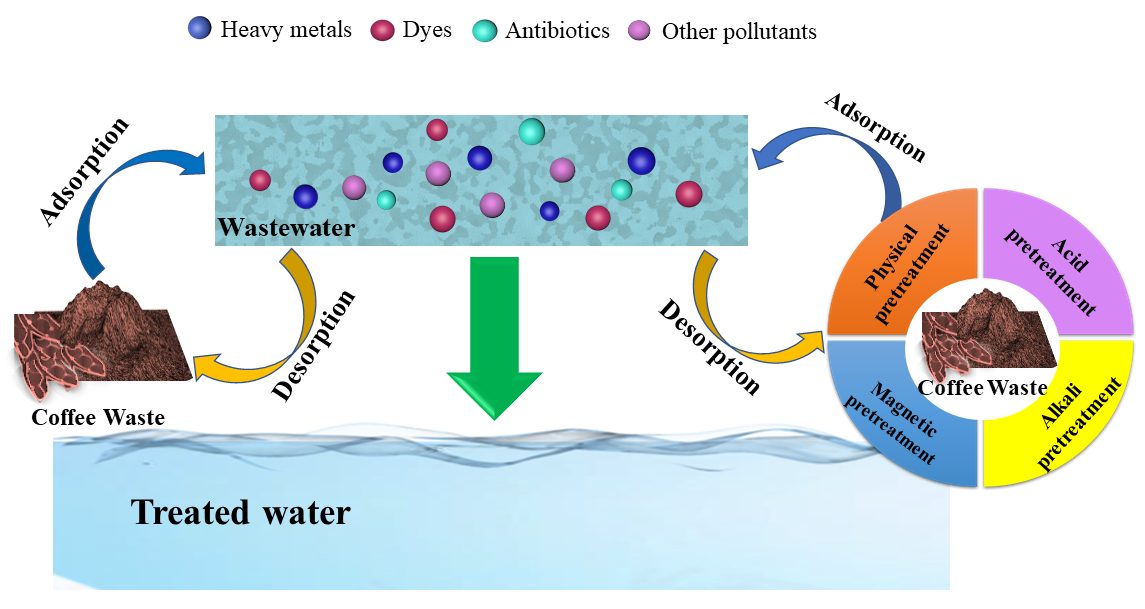咖啡渣吸附剂Removal of pollutants from wastewater using coffee waste as adsorbent: A review
Removal of pollutants from wastewater using coffee waste as adsorbent: A review
Recently, Dr Yi-Tong Wang (Associate Prof., College of Metallurgy and Energy, North China University of Science and Technology) and Prof. Zhen Fang published a review article in Journal of Water Process Engineering about using coffee waste as adsorbent to remove pollutants from wastewater.
The problem of water pollution is becoming more and more serious, and many pollutants are carcinogenic and pose a serious threat to global sustainable and green development. Adsorption is a promising wastewater treatment process, and agricultural wastes as adsorbents are popular in various wastewater treatments. The world produces > 6 million tons of coffee crops annually, and every ton of coffee generates 0.68 ton of coffee waste. Because coffee waste (i) has a surface with a porous structure, (ii) contains cellulose, hemicellulose, and lignin structure that can provide abundant functional groups, and (iii) is recyclable to make it have remarkable performance in wastewater treatment, and its reuse not only saves processing costs but also contributes to the sustainable development of the environment. This review focuses on the application of coffee waste sorbents in the removal of pollutants from wastewater. The methods and advantages and disadvantages of physical pretreatment, acid pretreatment, alkali pretreatment, and magnetic pretreatment of coffee waste were reviewed. Four types of adsorption experiments including adsorption experiments, adsorption kinetics, adsorption isotherms, and adsorption thermodynamics of heavy metals, dyes, antibiotics, and other organic pollutants removal efficiency are investigated and their adsorption potential is discussed. Finally, a brief conclusion and future perspective for coffee waste that applies to wastewater treatment are provided. This review paper provides a new idea for the application of solid waste to wastewater treatment.
Related results were accepted in Journal of Water Process Engineering:
Le-Le Kang, Ya-Nan Zeng, Yi-Tong Wang, Jun-Guo Li, Fu-Ping Wang, Ya-Jun Wang, Qing Yu, Xiao-Man Wang, Rui Ji, Di Gao, Zhen Fang. Removal of pollutants from waste water using coffee waste as adsorbent: A review. Journal of Water Process Engineering, 2022, 49, 103178. https://doi.org/10.1016/j.jwpe.2022.103178

The coffee waste without any pretreatment or after physical pretreatment, acid-base pretreatment and magnetic pretreatment can effectively remove heavy metals, dyes, antibiotics and other pollutants in wastewater. 未经任何预处理或经过物理预处理、酸预处理、碱预处理和磁性预处理的咖啡废弃物可有效去除废水中的重金属、染料、抗生素和其他污染物。
咖啡废弃物用作吸附剂去除废水中污染物的研究进展
最近,王一同博士(华北理工大学冶金与能源学院副教授)和方真教授在国际学术期刊Journal of Water Process Engineering 发表题为“咖啡废料用作吸附剂去除废水中污染物的研究进展”的综述性论文。
水污染问题越来越严重,许多污染物具有致癌性,对全球可持续发展和绿色发展构成严重威胁。吸附是一种很有前途的废水处理方法,农业废弃物作为吸附剂在各种废水处理中得到广泛应用。全世界每年生产600万吨咖啡农作物,每生产1吨咖啡产生0.68吨咖啡废弃物。因为咖啡废弃物(i)具有多孔结构的表面;(ii)含有纤维素、半纤维素和木质素结构,能够提供丰富的官能团;(iii)具有可回收性。这些使其在废水处理中具有显著的性能,其重复利用不仅节约了处理成本,而且有利于环境的可持续发展。本文重点综述了咖啡废弃物吸附剂去除废水中污染物的应用。综述了咖啡废弃物的物理预处理、酸预处理、碱预处理和磁性预处理的方法及其优缺点。研究了吸附实验、吸附动力学、吸附等温线、吸附热力学等四类吸附实验对重金属、染料、抗生素和其他有机污染物的去除效率,并讨论了它们的吸附潜力。最后,对咖啡废弃物在废水处理中的应用前景进行了简要的总结和展望。该论文为固体废物应用于废水处理方面提供了新思路。详情可见:
Le-Le Kang, Ya-Nan Zeng, Yi-Tong Wang, Jun-Guo Li, Fu-Ping Wang, Ya-Jun Wang, Qing Yu, Xiao-Man Wang, Rui Ji, Di Gao, Zhen Fang. Removal of pollutants from wastewater using coffee waste as adsorbent: A review. Journal of Water Process Engineering, 2022, 49, 103178. https://doi.org/10.1016/j.jwpe.2022.103178.